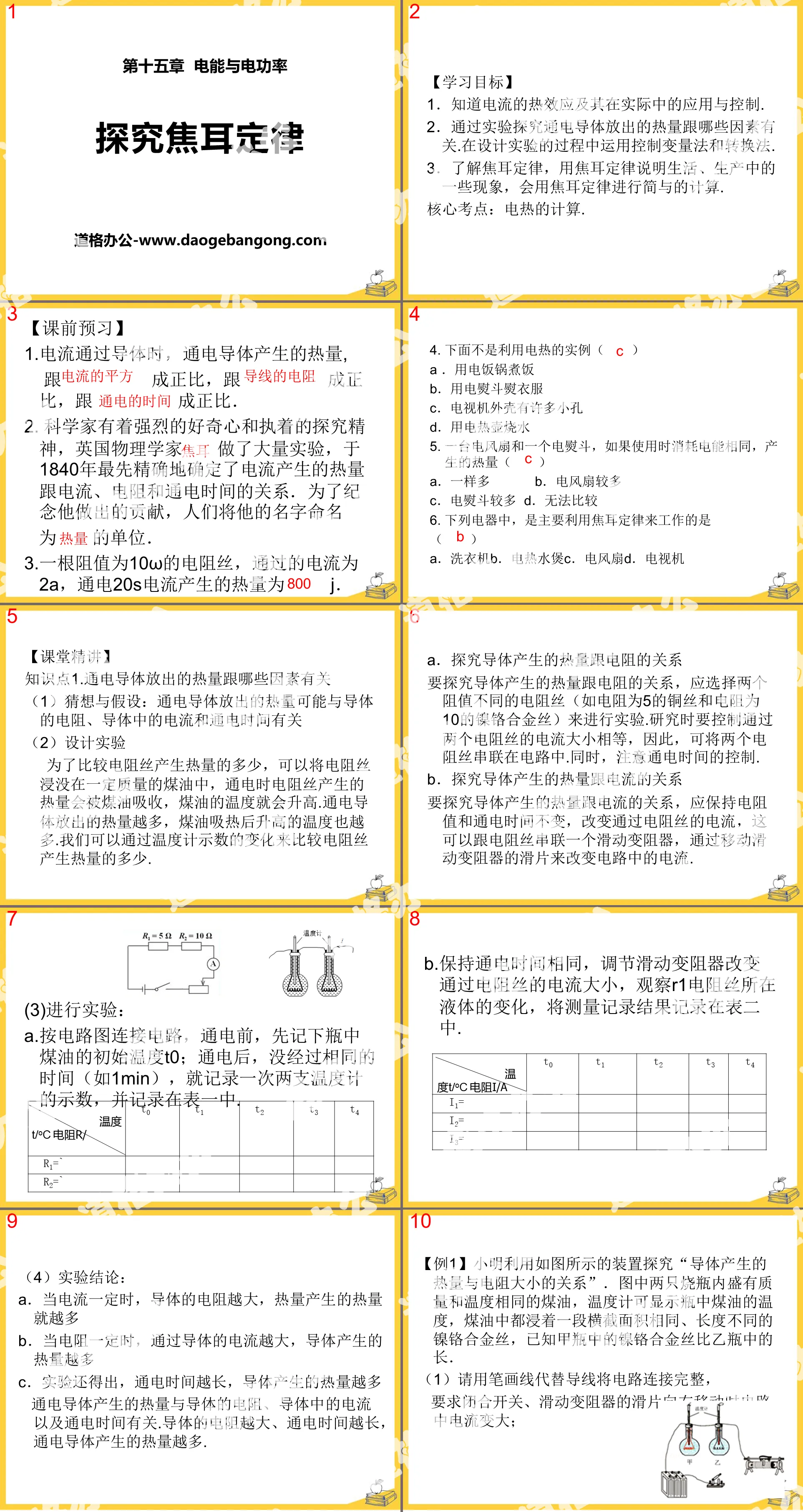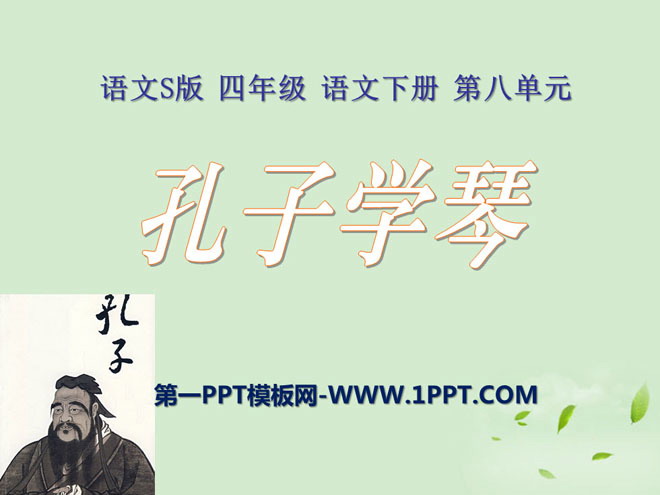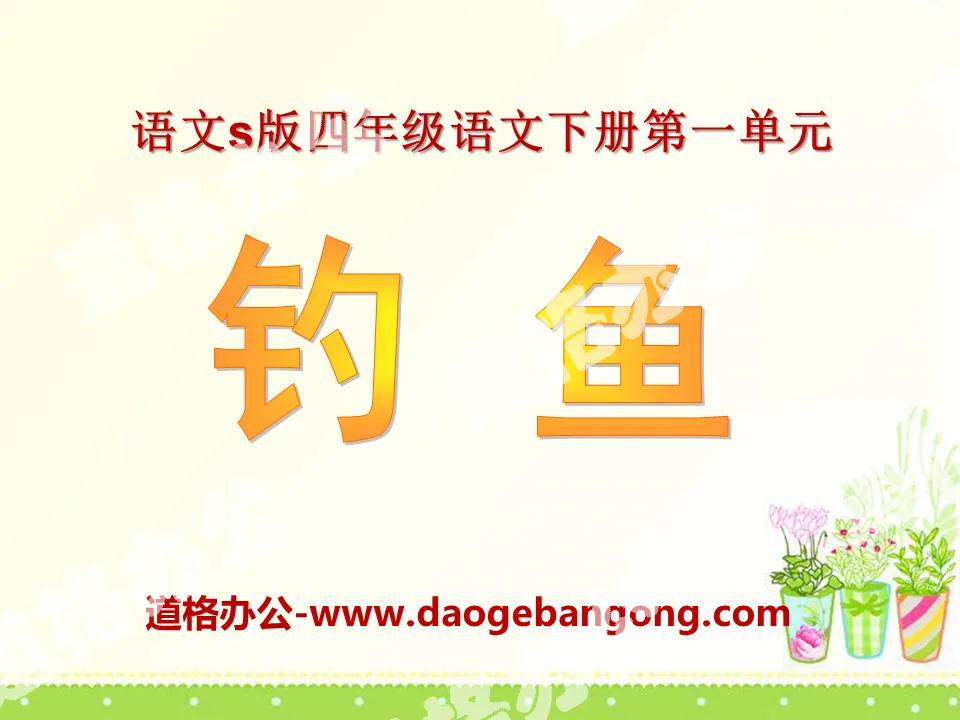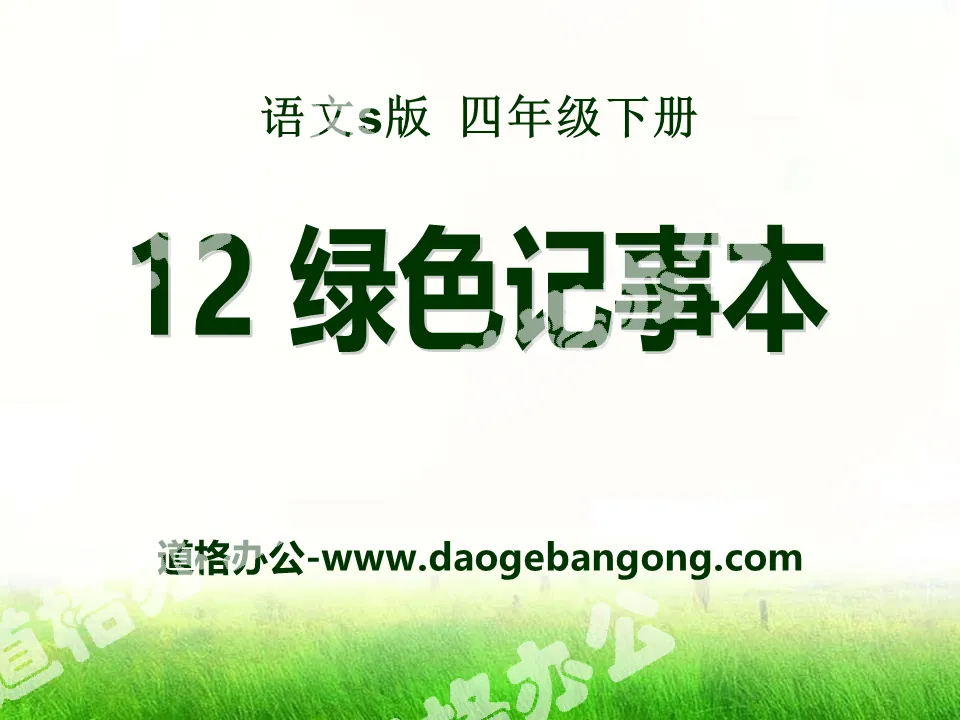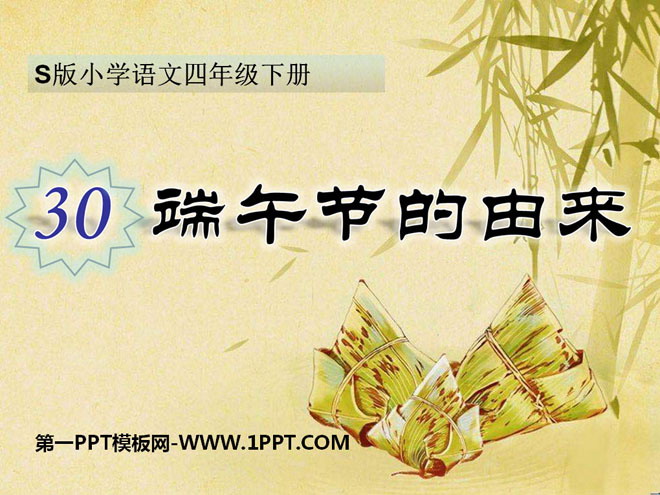
| Category | Format | Size |
|---|---|---|
| Guangdong and Shanghai Edition Ninth Grade Physics Volume 1 | pptx | 6 MB |
Description
"Exploring Joule's Law" Electric Energy and Electric Power PPT Courseware
【learning target】
1. Understand the thermal effects of electric current and its application and control in practice.
2. Through experiments, we explore the factors related to the heat released by energized conductors. In the process of designing experiments, we use the control variable method and the conversion method.
3. Understand Joule's law, use Joule's law to explain some phenomena in life and production, and be able to use Joule's law to calculate simple sums.
Core test point: Calculation of electric heat.
【Preview before class】
1. When current passes through a conductor, the heat generated by the energized conductor is proportional to ________, proportional to ________, and proportional to ________.
2. Scientists have strong curiosity and persistent spirit of inquiry. The British physicist ________ conducted a large number of experiments and was the first to accurately determine the relationship between the heat generated by electric current and current, resistance and energization time in 1840. In order to commemorate his contribution, people named the unit _________ after him.
3. A resistance wire with a resistance of 10Ω, the current flowing through it is 2A, and the heat generated by the current when it is energized for 20s is ________J.
[Intensive lectures in class]
Knowledge point 1. What factors are related to the heat released by an energized conductor?
(1) Conjecture and hypothesis: The heat released by an energized conductor may be related to the resistance of the conductor, the current in the conductor and the energization time.
(2) Design experiments
In order to compare the amount of heat generated by the resistance wire, the resistance wire can be immersed in a certain quality of kerosene. When energized, the heat generated by the resistance wire will be absorbed by the kerosene, and the temperature of the kerosene will rise. The more heat the energized conductor releases, the lower the kerosene. The more the temperature rises after absorbing heat. We can compare the amount of heat generated by the resistance wire through the change in the thermometer indication.
a. Explore the relationship between the heat generated by a conductor and its resistance
To explore the relationship between the heat generated by the conductor and the resistance, two resistance wires with different resistance values (such as a copper wire with a resistance of 5 and a nickel-chromium alloy wire with a resistance of 10) should be selected for the experiment. During the research, two resistance wires must be controlled. The currents of the resistance wires are equal, so two resistance wires can be connected in series in the circuit. At the same time, pay attention to the control of the power-on time.
b. Explore the relationship between heat generated by conductors and current flow
To explore the relationship between the heat generated by the conductor and the current, the resistance value and power-on time should be kept constant, and the current through the resistance wire should be changed. This can be done by connecting a sliding rheostat in series with the resistance wire, and changing the resistance in the circuit by moving the slider of the sliding rheostat. current.
[Example 1] Xiao Ming uses the device as shown in the picture to explore "the relationship between the heat generated by the conductor and the resistance size." The two flasks in the picture contain kerosene of the same quality and temperature. The thermometer can display the temperature of the kerosene in the bottle. A section of nickel-chromium alloy wire with the same cross-sectional area and different lengths is immersed in the kerosene. It is known that the nickel in bottle A The chromium alloy wire is longer than the one in bottle B.
(1) Please use stroke lines instead of wires to connect the circuit completely. It is required that the current in the circuit becomes larger when the switch is closed and the slider of the sliding rheostat moves to the right;
(2) Connect the circuit correctly. After closing the switch, you can observe that the reading of the thermometer in the bottle ______ (optional "A" or "B") rises faster, which shows that: when the current and power-on time are the same The greater the resistance of the conductor, the more heat is generated.
(3) This device can also be used to explore the relationship between the heat generated by the current passing through the conductor and ______. During the experiment, move the slide of the sliding rheostat and observe the thermometer indication in the ______ (optional "same" or "different") flask. How fast the number rises.
(4) Xiao Ming believes that after improving the device, he can also conduct an experiment of "comparing the specific heat capacities of water and kerosene". Then he should replace the kerosene in one of the flasks with water. The specific requirements for this part of the water are_ _____, and the resistance of the metal wires in flasks A and B must be ______. The amount of heat absorbed by water and kerosene is reflected by ______ (optional "thermometer rise indication" or "heating time"). Through experiments, it was found that the temperature of water rises slowly, indicating that the specific heat capacity of ______ is relatively small.
Knowledge point 2. Joule’s law
(1) Content: The heat generated when current flows through a conductor is proportional to the square of the current, proportional to the resistance of the conductor, and proportional to the energization time. This law is called Joule's law.
(2) Formula: Q=I2Rt
Q represents the heat generated when current flows through the conductor, the unit is J; I represents the current passing through the conductor, the unit is A; R represents the resistance of the conductor, the unit is; t represents the energization time, the unit is s.
(3) Derive the formula: Q=Pt; Q=UIt; Q=
These three formulas only apply to situations where all electrical energy is converted into internal energy, that is, in a purely resistive circuit where all the work done by the current is used to generate heat.
[Example 2] (2014·Zunyi) After an electric furnace is powered on, the electric furnace wire becomes hot and red, but the wire connected to the electric furnace wire is not very hot. The rated voltage of this electric furnace is 220V, the rated power is 1100W, and the wire connected to the electric furnace wire is not very hot. The resistance of the wire is 0.1Ω, the electric furnace works normally for 10 minutes, the current passing through the wire is _____A, and the heat generated on the wire is
[Exercise 2] (2014·Dazhou) A motor with a coil resistance of 0.3Ω is connected to a 12V power supply. The current flowing through the motor is 0.5A. The heat generated by the current in 2 minutes is _____J, and the mechanical energy converted into it is _____J.
[In-class testing]
1. (2014•Wuxi) In order to explore "what factors are related to the heat generated by current passing through a conductor", a student sealed two sections of resistance wires R1 and R2 with different resistance values in two identical flasks, and designed As shown in the figure, there are two sets of devices A and B. It is known that the voltage of the batteries used is equal and remains unchanged, R1 < R2, and the mass of kerosene put into the flask is equal. Among the following statements about this research activity, the incorrect one is ()
A. In this experiment, the amount of heat generated by the current passing through the conductor is reflected by the change in the thermometer reading.
B. A device explores whether the heat generated by current flowing through a conductor is related to resistance
C. Comparing the changes in the readings of two thermometers a and c during the same power-on time, we can explore whether the heat generated by the current is related to the current.
D. During the same power-on time, the resistance wire in the flask where the d thermometer is located generates the most heat.
2. (2014•Hengyang) Insert two resistance wires R1 and R2 into two bottles of kerosene of equal quality, A and B respectively, and connect them to the circuit in series, R1: R2 = 2: 3. After powering on for a period of time, the ratio of heat generated by R1 and R2 is ( )
A. 3:2 b. 2:3
C. 4:9 D. 9:4
3. Among the following examples, the one that can prevent the harm of electric heat is ( )
A. Electric mattress for heating
B. Electric thermal insulation device in the clothes worn by high-altitude pilots
C. There are many small holes in the casings of radios and televisions
D. Electric heating incubator for incubating poultry
Chapter 15 Review Lesson
Test point 1. Electric energy and electric energy meter
Analysis of test points: The focus of this test point is the calculation of electric energy based on the reading of the electric energy meter and the meaning of each parameter in the electric energy meter.
1. Important parameters of electric energy meter:
(1) "220V" means that the rated voltage of the electric energy meter is 220V;
(2) "10 (20) A" means that the calibrated current of this electric energy meter is 10 A and the rated maximum current is 20 A;
(3) "50Hz" means that this electric energy meter is used in a 50 Hz AC circuit;
(4) "600r/kW·h" means that the electric energy meter rotates 600 times for every kilowatt hour consumed.
Test point 2 Electric power (high frequency test point)
Analysis of test points: This test point is a high-frequency test point for the Guangdong High School Entrance Examination. The focus of the test is on the calculation of electric power. The test is relatively difficult. Generally, it is a comprehensive question with a large proportion of points. You must thoroughly understand this test point when preparing for the test. What you need to master Knowledge points:
(1) Electric power is a physical quantity that indicates how quickly an electrical appliance consumes electrical energy, represented by the symbol P.
(2) The electrical power is equal to the electrical energy consumed by the electrical appliance in 1 second. The calculation formula of electric power is: P- W/t= UI.
(3) The main international unit of electric power is: watt, represented by the symbol W; another common unit is: kilowatt, represented by the symbol kW; the conversion relationship between them is: 1kW=1 000W.
(4) Rated voltage refers to the voltage of the electrical appliance when it is working normally; rated power refers to the power of the electrical appliance at the rated voltage. When the actual voltage of the bulb is on the high side, the actual power of the bulb will be on the high side and the bulb will glow strongly; when the actual voltage of the bulb is on the low side, the actual power of the bulb will be on the low side and the bulb will glow dimly.
Keywords: Electric energy and electric power teaching courseware, Exploring Joule's Law teaching courseware, Guangdong and Shanghai edition ninth grade physics PPT courseware download, Ninth grade physics slide courseware download, Electric energy and electric power PPT courseware download, Exploring Joule's Law PPT courseware download, .PPT Format;
For more information about the "Electric Energy and Electric Power Exploring Joule's Law" PPT courseware, please click the Electric Energy and Electric Power ppt Exploring Joule's Law ppt tag.
"Exploring Joule's Law" Electric Energy and Electric Power PPT Courseware 3:
"Exploring Joule's Law" Electric Energy and Electric Power PPT Courseware 3 1. Thermal Effect of Current: When electric current passes through a conductor, the conductor always generates heat. This phenomenon is called the thermal effect of electric current. 2. What factors are related to the thermal effect of current? Conjecture: 1. The heat of electric current...
"Exploring Joule's Law" Electric Energy and Electric Power PPT Courseware 2:
"Exploring Joule's Law" Electric Energy and Electric Power PPT Courseware 2 Learning Objectives: 1. Know the relationship between heat production, resistance and current of electrical appliances. 2. Be able to design experiments to verify the relationship between the heat generation of the resistor and current, voltage, and resistance, and be able to analyze the experimental data to obtain...
File Info
Update Time: 2024-08-06
This template belongs to Physics courseware Guangdong and Shanghai Edition Ninth Grade Physics Volume 1 industry PPT template
"Exploring Joule's Law" Electric Energy and Electric Power PPT Courseware Simple campus recruitment activity planning plan summary enterprise and institution recruitment publicity lecture PPT template is a general PPT template for business post competition provided by the manuscript PPT, simple campus recruitment activity planning plan summary enterprise and institution recruitment promotion Lecture PPT template, you can edit and modify the text and pictures in the source file by downloading the source file. If you want more exquisite business PPT templates, you can come to grid resource. Doug resource PPT, massive PPT template slide material download, we only make high-quality PPT templates!
Tips: If you open the template and feel that it is not suitable for all your needs, you can search for related content "Exploring Joule's Law" Electric Energy and Electric Power PPT Courseware is enough.
How to use the Windows system template
Directly decompress the file and use it with office or wps
How to use the Mac system template
Directly decompress the file and use it Office or wps can be used
Related reading
For more detailed PPT-related tutorials and font tutorials, you can view: Click to see
How to create a high-quality technological sense PPT? 4 ways to share the bottom of the box
Notice
Do not download in WeChat, Zhihu, QQ, built-in browsers, please use mobile browsers to download! If you are a mobile phone user, please download it on your computer!
1. The manuscript PPT is only for study and reference, please delete it 24 hours after downloading.
2. If the resource involves your legitimate rights and interests, delete it immediately.
3. Contact information: service@daogebangong.com
"Exploring Joule's Law" Electric Energy and Electric Power PPT Courseware, due to usage restrictions, it is only for personal study and reference use. For commercial use, please go to the relevant official website for authorization.
(Personal non-commercial use refers to the use of this font to complete the display of personal works, including but not limited to the design of personal papers, resumes, etc.)
Preview
